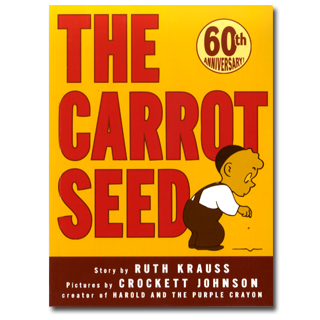
A FEW OTHER EVENTS FOR
MAY 17:
- Happy birthday Eloise Greenfield (Honey, I Love and Other Poems), Nancy Polette (Eight Cinderellas), Gary Paulsen (Hatchet), and Jeanne M. Lee (I Once Was a Monkey).
- It’s the birth date of the New York Stock Exchange, formed in 1792. Read Six Days in October: The Stock Market Crash of 1929 by Karen Blumenthal.
- In 1939, the Columbia Lions and Princeton Tigers play in the first televised sporting event in the U.S, a collegiate baseball game. Read Library Lion by Michelle Knudson, illustrated by Kevin Hawkes, and Riding the Tiger by Eve Bunting, illustrations by David Frampton.
- It’s Pack Rat Day. Read The Return of Pete Pack Rat by Robert Quakenbush.
In May of 1945—around the time of Victory in Europe Day in World War II—a small book appeared on the list of Harper and Brothers. A quirky, offbeat title, it was not advertised that year and did not seem a likely candidate for celebrity status in the picture book world. But when it comes to children’s books for the very young (those one to three years old), simplicity often wins out over other approaches, and The Carrot Seed exemplifies simplicity.
The creation of writer Ruth Krauss, this small gem stands as a testament to revision. When asked how long it took her to write The Carrot Seed, Krauss always said “her whole life.” She had to pare the story down, again and again, until she got its essence.
In this saga, a young child plants a seed. Everyone else believes it won’t grow (or as they say, “come up”) except the child. “And then one day,/a carrot came up/just as the little boy had known it would.” A statement about childhood belief and faith, the book—sometimes called “the little book with the big idea”—has become one of our most cherished American picture books.
Krauss could be quite acerbic when she wanted to, and even her editor Ursula Nordstrom addressed her in letters as “Dear Ruthless.” Krauss often terrorized her illustrators. On one notable occasion she took some drawings offered her by a frightened, young illustrator and deposited them in a wastebasket. But she pronounced the drawings for The Carrot Seed “perfect.”
Of course, Krauss was married to the illustrator of this book, David Johnson Leisk, aka Crockett Johnson who also created Harold and the Purple Crayon. But it would be hard to image any other rendition of this book or of the child in the drawings. Johnson, who was himself bald, always drew bald characters or, in the case of The Carrot Seed, a child with a single hair. He maintained that bald heads were easier to draw than ones with hair.
Happy birthday to The Carrot Seed. For all these years, children have been absorbing its subtle message about the power of positive thinking.
Here’s a page from The Carrot Seed:
And then, one day,
a carrot came up
just as the little boy
had known it would.
Originally posted May 17, 2011. Updated for .







That is the line that really stuck with me as an adult! I was first introduced to this book as an adult and enjoyed the lesson of patience and persistent thought. It’s a text that I believe should be shared with every child and adult!!
Ruth Krauss’ The Carrot Seed and Harold and the Purple Crayon are right up there with Margaret Wise Brown’s Good Night Moon as the best of picture books for preschoolers.
A simple, wonderful book, I love it. By the way, though, “Harold & the Purple Crayon” was both written & illustrated by Crockett Johnson; it’s not a Ruth Krauss book.
It’s a wonderful book! I’m glad that I actually saw Crockett Johnson once. Bald he was!
OK, so I know there’s supposedly no such thing as a perfect book… but this one comes pretty close.
Fran: How wonderful to hear that you met him — and that you confirm the baldness.
John: Thanks for your catch on the also recommended line. It is now correct.
Great comments. Thanks to everyone.
Wonderful post! Thank you for all this fascinating information.
Just got hands on this.
A simple, yet powerful message.
And that art reminds me a little of the ancient basic Felix the Cat images.
Lots of fun behind-the-scenes info in this post – thanks Anita!
When I worked at Barnes and Noble, there was a woman who was a sociology professor and quite a character. She bought this book for people to encourage them. I must have told that story to my mother because one day she bought it for me, in a very discouraging time of my life. It is one of my most treasured possessions.
I love this post, Anita! I love THE CARROT SEED, too. Thanks for all the interesting information.
Did anyone else have the record? I can still sing the mother’s song and the older brother’s “Nyah! Nyah!’ song. The remember the mother’s song of gentle discouragement is quite beautifully haunting.
Betsy, I still have the record, and yes it is engraved in my mind—especially the older brother’s response, and the last line in the story! Loved it!